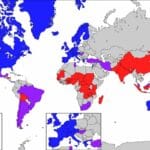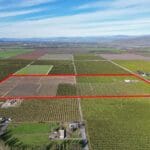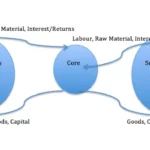Georgia, known for its peaches and Southern charm, also boasts a surprising array of geological wonders. From the majestic mountains of the north to the sandy beaches of the coast, Georgia’s landscape captivates residents and visitors alike. But what forces have sculpted this diverse terrain?
Unveiling Georgia’s Diverse Landforms: An In-Depth Analysis
The answer lies in the state’s fascinating geological history. Georgia sits at a unique crossroads of five distinct physiographic provinces, each shaped by millions of years of geological processes. These provinces, like brushstrokes on a canvas, have created a tapestry of mountains, valleys, plains, and coastal wonders.
The Five Physiographic Provinces
- Appalachian Plateau: Located in the northwestern corner of the state, the Appalachian Plateau is the state’s tag end of a much larger geological region. This region, characterized by rugged terrain and plateaus, hints at the powerful forces that have shaped the eastern United States.
- Valley and Ridge: Stretching south from the Appalachian Plateau, the Valley and Ridge province features long, parallel ridges separated by fertile valleys. Millions of years ago, these valleys and ridges were probably formed by the folding and faulting of sedimentary rocks, leaving behind a pattern of alternating highs and lows that define the region’s landscape.
- Blue Ridge: Home to Georgia’s highest peaks, including Brasstown Bald, the Blue Ridge Mountains dominate the northeastern part of the state. These ancient mountains were likely formed by tectonic uplift millions of years ago, leaving a legacy of rugged beauty and diverse ecosystems.
- Piedmont: Situated between the mountains and the coast, the Piedmont is a gently sloping plateau region. This region boasts striking granite outcrops, known as monadnocks, that stand as silent sentinels to the forces of erosion that have shaped the landscape over eons.
- Coastal Plain: Stretching from the fall line to the Atlantic Ocean, the Coastal Plain is the state’s most expansive physiographic region. This region features a gently sloping landscape shaped by ancient sea level changes, resulting in sandy beaches, barrier islands, and expansive marshes.
Beyond the Provinces: Notable Landform Features
In addition to the five physiographic provinces, certain landform features stand out as prominent features on Georgia’s landscape:
- The Fall Line: A significant geological boundary, the Fall Line marks the transition between the hard rocks of the Piedmont and the softer sediments of the Coastal Plain. This boundary is where rivers, flowing from the higher elevations, often form waterfalls and rapids, creating opportunities for early industry and shaping settlement patterns. Notable cities like Augusta, Macon, and Columbus developed along the Fall Line, taking advantage of the water power provided.
- The Okefenokee Swamp: Shrouded in mystery and teeming with life, the Okefenokee Swamp is a vast and captivating natural wonder. As North America’s largest blackwater swamp, it occupies a depression on the Coastal Plain and harbors a unique ecosystem with astonishing biodiversity. Its dark, tea-colored waters, reflecting the ancient cypress trees draped in Spanish moss, create an otherworldly atmosphere. The Okefenokee Swamp stands as a testament to the power of water, plants, and time to craft extraordinary landscapes.
- Appalachian Mountains: While the Appalachian Mountains stretch far beyond Georgia’s borders, their presence in the northern part of the state is undeniable. These peaks offer breathtaking vistas, drawing visitors eager to experience the allure of mountain landscapes. The Appalachian Trail, a famed hiking route, winds its way through this region, offering a glimpse into the natural world.
- Chattahoochee and Savannah Rivers: These rivers are more than just waterways; they are lifelines that have shaped Georgia’s history and development. The Chattahoochee River, originating in the Blue Ridge Mountains, flows south to form part of the state’s western boundary before joining the Flint River to become the Apalachicola River. The Savannah River, also originating in the Blue Ridge Mountains, defines the state’s eastern boundary. These rivers have served as transportation routes, sources of water for agriculture and industry, and continue to be vital resources.
- Barrier Islands: Like guardians protecting the mainland, Georgia’s barrier islands stand sentinel against the Atlantic Ocean. These islands, sculpted by waves and tides, are dynamic environments, constantly shifting and changing. Popular destinations like Tybee Island, Jekyll Island, and St. Simons Island, each with its unique character, draw visitors with their pristine beaches, maritime forests, and rich history.
Shaping the Land: Forces of Change
The incredible diversity of Georgia’s landforms is a testament to the powerful forces that have been at work for millions of years. These forces, both large and small, continue to shape the landscapes we see today.
Tectonic Plates: The Earth’s Moving Foundation
The Earth’s crust, far from being a solid, unyielding surface, is fractured into massive pieces called tectonic plates. Like giant puzzle pieces in slow motion, these plates are constantly moving, albeit at rates measured in millimeters per year. The interactions between these plates are responsible for some of the most dramatic geological events:
- Convergent Boundaries: When plates collide head-on, the immense pressure can buckle and uplift the Earth’s crust, creating mountain ranges. The majestic peaks of the Himalayas, for example, are the result of the ongoing collision between the Indian and Eurasian tectonic plates. Geologists believe that the Appalachian Mountains, including those found in Georgia, owe their existence to similar collisions that occurred hundreds of millions of years ago.
- Divergent Boundaries: At divergent boundaries, plates move apart, allowing molten rock from the Earth’s mantle to rise and solidify, creating new crust. This process is most evident in the mid-ocean ridges, underwater mountain ranges that mark the boundaries between diverging plates.
- Transform Boundaries: Where plates slide past each other horizontally, immense stress builds up, which can be suddenly released in the form of earthquakes. The San Andreas Fault in California, a notorious transform boundary, marks the boundary between the Pacific and North American plates.
Erosion: The Sculptor of Landscapes
While tectonic forces may provide the raw materials and the grand gestures, erosion is the meticulous artist that refines and shapes the land over time. Water, wind, and ice act as erosion’s tools, each leaving its distinctive mark on the landscape:
- Water Erosion: Water is arguably the most powerful erosive force on Earth. Rivers carve deep canyons and valleys, carrying away sediment that is eventually deposited downstream, forming floodplains and deltas. Rainfall, too, plays a role, dissolving soluble rocks and carrying away loose soil.
- Wind Erosion: In arid and semi-arid regions, wind acts as a sculptor, carrying fine particles of sand and dust that abrade rock surfaces and sculpt sand dunes into ever-shifting forms.
- Ice Erosion: Glaciers, massive rivers of ice, are powerful agents of erosion. As they slowly flow downhill, they carve out U-shaped valleys, transport huge boulders over vast distances, and grind down rock surfaces, leaving behind polished surfaces and glacial striations.
Weathering: Breaking Down the Earth’s Surface
While erosion transports weathered material, weathering is the process of breaking down rocks, soil, and minerals through contact with the Earth’s atmosphere, water, and biological organisms. This process, often invisible to the naked eye, can be either mechanical or chemical:
- Mechanical Weathering: This type of weathering occurs when physical forces break down rocks into smaller pieces without altering their chemical composition. Temperature changes, for example, can cause rocks to expand and contract, leading to cracks.
- Chemical Weathering: Chemical weathering alters the chemical composition of rocks through reactions with water, atmospheric gases, or biological activity. For example, acidic rainwater can dissolve certain types of rocks, such as limestone, leading to the formation of caves and sinkholes.
Human Impact: A New Era of Change
Humans, relative newcomers to the geological timescale, have become increasingly influential in shaping the Earth’s surface. Our activities, from agriculture and urbanization to mining and infrastructure development, have altered landscapes and accelerated natural processes:
- Land Use Changes: Deforestation, for example, can lead to increased soil erosion. When vegetation is removed, the soil is left exposed to the erosive forces of wind and rain. Agriculture, while essential for food production, can also alter soil structure and increase erosion rates.
- Urbanization: As cities grow, they often expand into previously undeveloped areas, covering land with impermeable surfaces like concrete and asphalt. This reduces water infiltration, increases runoff, and can lead to more frequent and severe flooding.
- Mining: The extraction of minerals and fossil fuels can dramatically alter landscapes, leaving behind open pits, waste piles, and altered drainage patterns. While mining is essential for providing resources, its impact on the surrounding environment must be carefully managed.
Climate Change: A Growing Influence
Climate change, driven by human activities that release greenhouse gases into the atmosphere, is having increasingly visible impacts on landforms and geological processes:
- Sea Level Rise: As global temperatures rise, glaciers and ice sheets melt at an accelerated rate, adding more water to the oceans and causing sea levels to rise. Coastal areas are particularly vulnerable to the effects of sea level rise, facing increased erosion, more frequent flooding, and potential displacement of communities.
- Changes in Precipitation Patterns: Climate change is also altering precipitation patterns, making some regions wetter and others drier. These shifts in rainfall can lead to increased flooding and erosion in some areas and drought and desertification in others.
Georgia: A Microcosm of Global Processes
Georgia, with its astonishing array of landforms, serves as a microcosm of the powerful forces shaping the Earth’s surface. Understanding how these geological processes have interacted over millions of years to sculpt the Peach State’s landscape provides a window into the dynamic nature of our planet. As we have seen, the forces of plate tectonics, erosion, weathering, and human activity are all interconnected, shaping not only the physical world around us but also the environments we inhabit.
As we move forward, it is crucial to recognize the increasing impact of human activities on landforms and geological processes. By understanding these connections and embracing sustainable practices, we can strive to protect Georgia’s natural heritage and ensure that its diverse landscapes continue to inspire wonder for generations to come.
















